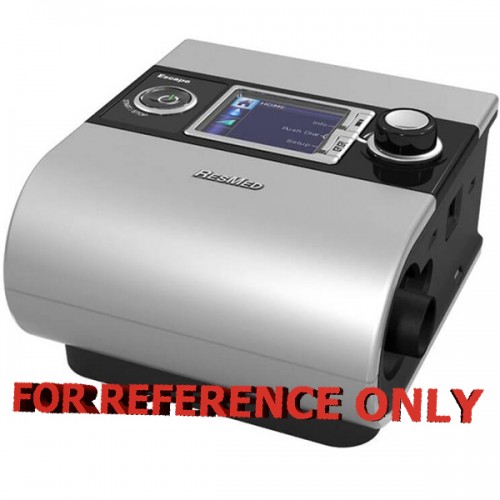The S9 Escape Auto self-adjusting system is indicated for the treatment of obstructive sleep apnoea (OSA) in patients weighing more than 30 kg.
The S9 Escape Auto self-adjusting system is intended for home and hospital use.
S9 Escape Auto™ Features
- Choice of APAP or fixed CPAP, with or without EPR
- AutoSet™ algorithm auto-adjusts to maintain optimal therapy pressure
- Climate Control maintains ideal humidification according to the real-time environment
- Easy-Breathe motor offers the quietest therapy available
- Easy-to-use controls and color LCD make menu navigation simple and intuitive
EPR technology
Designed to make therapy more comfortable, EPR maintains optimal treatment for the patient during inhalation and reduces the delivered mask pressure during exhalation.
You can select EPR in CPAP or APAP modes. EPR checklist
- You can set EPR to Off, Ramp Only, Full Time.
- You can select an EPR Level of Off, 1, 2, 3 cm H2 O or Patient (configurable by the patient).
- In CPAP mode you can set the EPR Inhale to Med or Fast. 9 When EPR is enabled, the delivered pressure will not drop below a minimum pressure of 4 cm H2 O, regardless of the settings
APAP technology
- The treatment pressure required by your patient may vary due to changes in sleep state, body position and airway resistance. The device analyses the state of your patient’s upper airway on a breath-by-breath basis and delivers pressure within the allowed range according to the degree of obstruction. The APAP algorithm adjusts treatment pressure as a function of three parameters: inspiratory flow limitation, snore, and apnoea.
Normal airway
- When your patient is breathing normally, the inspiratory flow measured by the device as a function of time shows a typically rounded curve for each breath.
Flow limitation
- As the upper airway begins to collapse, the shape of the inspiratory flow-time curve changes. The S9 recognises and treats traditional as well as less common flow-limited breath wave forms
Snore
- Snoring is sound generated by vibrations of the walls of the upper airway. It is often preceded by flow limitation or a partial obstruction of the airway
Apnoeas
- The APAP algorithm only treats apnoeas up to 10 cm H2 O and does not differentiate between different types of apnoeas. An obstructive apnoea is when the upper airway becomes severely limited or completely obstructed. APAP generally prevents obstructive apnoeas from occurring by responding to flow limitation and snoring. If an obstructive apnoea occurs, the device will respond by increasing pressure. The pressure will not rise above 10 cm H2 O when an apnoea is detected to prevent an inappropriate response to central apnoeas.
USER GUIDE - S9 Escape Auto CPAP

